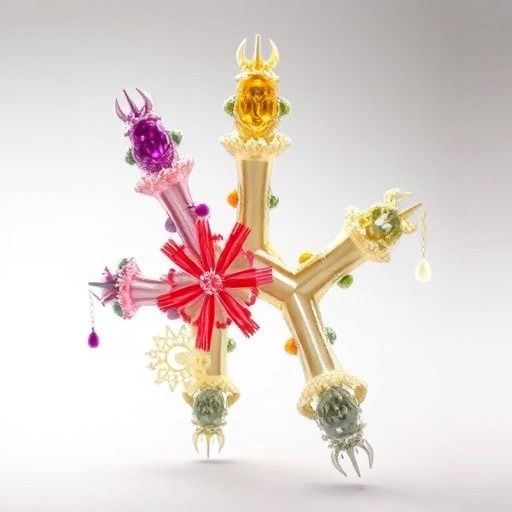
In a groundbreaking study, researchers have uncovered a remarkable anatomical feature in the subfamily Chalicotheriinae, known for its distinct evolutionary adaptations. These prehistoric mammals, often described as “strange hoofed creatures,” showcase a unique pathological phalangeal fusion that could shed light on their evolutionary functionality and ecological orientation. The exploration of this phenomenon not only contributes to our understanding of chalicotheres but also hints at the complex interplay between anatomical design and environmental pressures during their reign.
Chalicotheres, part of the larger order Perissodactyla, diversified from common ancestors shared with modern horses. This new study spearheaded by the trio of Kampouridis, Kyriakouli, and de Souza Ferreira, meticulously details a particular case of phalangeal fusion within this group that has never been documented before. The examination of fossilized remains provides a window into the evolutionary adaptations that may have enabled these animals to thrive in specific habitats, suggesting that their morphological uniqueness was a response to climatic and ecological challenges.
The study meticulously outlines the skeletal structure of chalicotheres, illustrating how their limbs were not merely supportive, but also multifunctional. The fusion of phalanges—bones of the fingers or toes—represents an advanced adaptation that may have implications for the mobility and behavior of these intriguing animals. In essence, what might seem like a deformity could very well have been an evolutionary strategy that enhanced their ability to navigate different terrains or facilitate unique feeding strategies.
.adsslot_mpWjaKeSJO{width:728px !important;height:90px !important;}
@media(max-width:1199px){ .adsslot_mpWjaKeSJO{width:468px !important;height:60px !important;}
}
@media(max-width:767px){ .adsslot_mpWjaKeSJO{width:320px !important;height:50px !important;}
}
ADVERTISEMENT
Detailed analysis of the interphalangeal structure indicates that these fused bones might have assisted in stabilizing the limbs, thus providing a potential advantage in locomotion over uneven surfaces. This structural adaptation could imply that chalicotheres had developed specific behavioral patterns that complemented their anatomical capabilities, effectively allowing them to exploit various ecological niches. This insight reshapes our understanding of how locomotion and manual dexterity evolved in response to environmental demands.
Moreover, the implications of this finding extend beyond mere anatomical curiosity. It highlights the significance of pathological conditions in evolutionary biology. The presence of a pathological fusion raises questions about the health and survival of individuals in the wild and how such variations might have been advantageous or detrimental in specific contexts. It opens up new pathways for exploring how individual variations might fit into the broader tapestry of evolutionary change within species.
In visualizing these creatures in their habitat, one must consider the role that climate played during their existence. The study notes that chalicotheres were predominantly found in regions characterized by open forest and woodlands, environments that would have demanded unique adaptations for survival. This ecological backdrop provides a critical context for understanding the functional significance of the phalangeal fusion, particularly how these anatomical traits may have facilitated grazing or foraging behaviors.
Progressing through the analysis, researchers employed advanced imaging techniques to reconstruct the limb morphology of chalicotheres, comparing these structures to both their extant relatives and other extinct species. The detailed 3D modeling conducted through this interdisciplinary approach highlighted the evolutionary pathways these mammoths took, illuminating the mysteries of their locomotive evolution. As scientists delve deeper into the fossil record, more intricate details about their ecology and behavior are likely to emerge, painting a comprehensive picture of their way of life.
Chalicotheres are an example of the myriad forms life can take in response to ecological pressures. Their distinct adaptations to herbivorous lifestyles tell a compelling story about the evolutionary arms race between species and their environments. The fusion of phalangeal bones can be interpreted as nature’s way of orchestrating anatomical innovations that serve specific survival functions, suggesting a theme of adaptive flexibility in the face of changing ecological landscapes.
Interestingly, this finding parallels other evolutionary phenomena observed in different taxa, underscoring a universal principle within biology—the notion that physical adaptations can serve dual purposes in promoting both mobility and stability. It points to the need for ongoing research that examines how structural changes in various species shape their evolutionary trajectories and ecological roles.
The researchers note that while much has been learned, this study is merely a stepping stone in understanding chalicotheres and their diverse adaptations. Future investigations could unveil other instances of pathological fusions or irregularities in fossilized remains, each telling its unique story of survival and adaptation. These stories have the potential to add layers of complexity to our knowledge of prehistoric life and the dynamics of evolutionary change.
As the study highlights, chalicotheres were not mere bystanders in their ecosystems; they were active participants, with their unique adaptations influencing their interactions with other species and their environments. By acknowledging the significance of their phalangeal fusion, we not only enrich our comprehension of these magnificent creatures but also inspire further inquiry into the evolutionary narratives encrypted within the fossil record.
In conclusion, the discovery of unique pathological phalangeal fusion in the chalicothere subfamily Chalicotheriinae opens up a wealth of avenues for future research, urging scientists to reexamine notions of adaptability and survival. This work serves as a vivid reminder of the intricate tapestry of life and the endless possibilities that evolution continues to unveil.
Subject of Research: Unique pathological phalangeal fusion in chalicotheres
Article Title: Unique pathological phalangeal fusion in the chalicothere subfamily Chalicotheriinae and the interphalangeal immobilization in chalicotheres.
Article References:
Kampouridis, P., Kyriakouli, C. & de Souza Ferreira, G. Unique pathological phalangeal fusion in the chalicothere subfamily Chalicotheriinae and the interphalangeal immobilization in chalicotheres.
Sci Nat 112, 59 (2025). https://doi.org/10.1007/s00114-025-02011-0
Image Credits: AI Generated
DOI: https://doi.org/10.1007/s00114-025-02011-0
Keywords: Chalicotheres, phalangeal fusion, evolutionary adaptation, ecology, locomotion, anatomical structure, fossil record.
Tags: adaptive traits in extinct mammalsChalicotheriinae anatomyecological pressures on chalicotheresevolutionary adaptations of chalicotheresfossilized remains of chalicotheresimplications of phalangeal fusionPerissodactyla suborder characteristicsphalangeal fusion in mammalsprehistoric mammal evolutionresearch on chalicotheresskeletal structure of chalicotheresunique adaptations in ancient species





